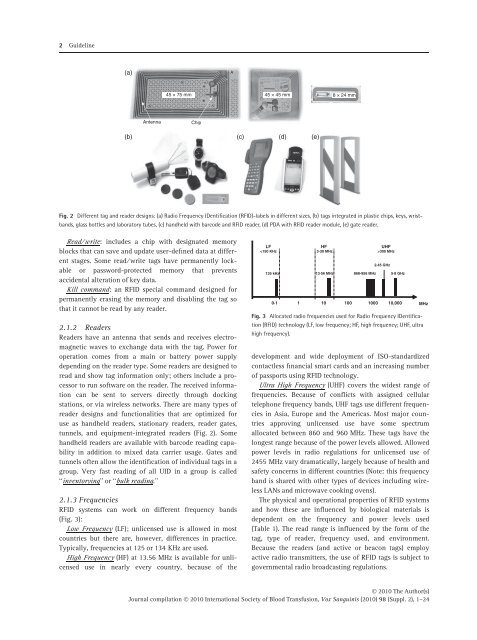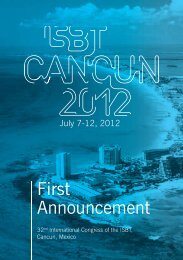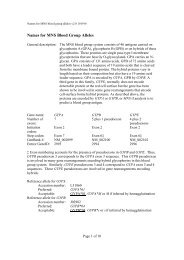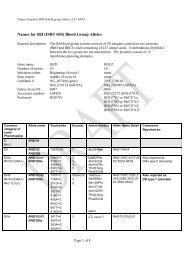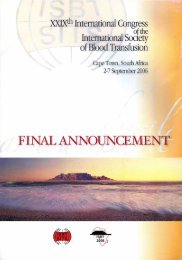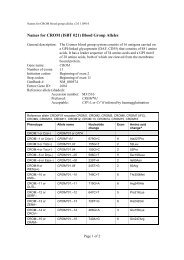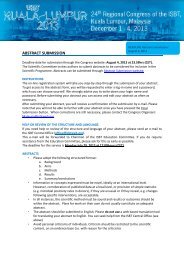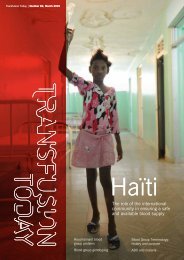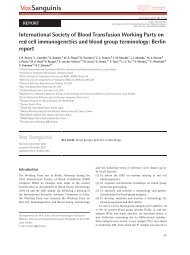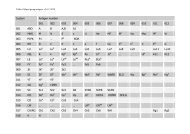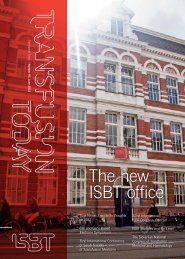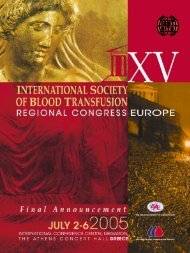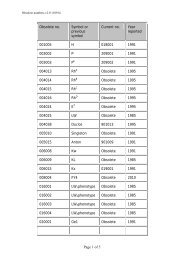2 Guidel<strong>in</strong>eFig. 2 Different tag and reader designs: (a) Radio Frequency IDentification (<strong>RFID</strong>)-labels <strong>in</strong> different sizes, (b) tags <strong>in</strong>tegrated <strong>in</strong> plastic chips, keys, wristbands,glass bottles and laboratory tubes, (c) handheld with barcode and <strong>RFID</strong> reader, (d) PDA with <strong>RFID</strong> reader module, (e) gate reader.Read ⁄ write: <strong>in</strong>cludes a chip with designated memoryblocks that can save and update user-def<strong>in</strong>ed data at differentstages. Some read ⁄ write tags have permanently lockableor password-protected memory that preventsaccidental alteration <strong>of</strong> key data.Kill command: an <strong>RFID</strong> special command designed <strong>for</strong>permanently eras<strong>in</strong>g <strong>the</strong> memory and disabl<strong>in</strong>g <strong>the</strong> tag sothat it cannot be read by any reader.2.1.2 ReadersReaders have an antenna that sends and receives electromagneticwaves to exchange data with <strong>the</strong> tag. Power <strong>for</strong>operation comes from a ma<strong>in</strong> or battery power supplydepend<strong>in</strong>g on <strong>the</strong> reader type. Some readers are designed toread and show tag <strong>in</strong><strong>for</strong>mation only; o<strong>the</strong>rs <strong>in</strong>clude a processorto run s<strong>of</strong>tware on <strong>the</strong> reader. The received <strong>in</strong><strong>for</strong>mationcan be sent to servers directly through dock<strong>in</strong>gstations, or via wireless networks. There are many types <strong>of</strong>reader designs and functionalities that are optimized <strong>for</strong>use as handheld readers, stationary readers, reader gates,tunnels, and equipment-<strong>in</strong>tegrated readers (Fig. 2). Somehandheld readers are available with barcode read<strong>in</strong>g capability<strong>in</strong> addition to mixed data carrier usage. Gates andtunnels <strong>of</strong>ten allow <strong>the</strong> identification <strong>of</strong> <strong>in</strong>dividual tags <strong>in</strong> agroup. Very fast read<strong>in</strong>g <strong>of</strong> all UID <strong>in</strong> a group is called‘‘<strong>in</strong>ventory<strong>in</strong>g’’ or ‘‘bulk read<strong>in</strong>g.’’2.1.3 Frequencies<strong>RFID</strong> systems can work on different frequency bands(Fig. 3):Low Frequency (LF); unlicensed use is allowed <strong>in</strong> mostcountries but <strong>the</strong>re are, however, differences <strong>in</strong> practice.Typically, frequencies at 125 or 134 KHz are used.High Frequency (HF) at 13.56 MHz is available <strong>for</strong> unlicenseduse <strong>in</strong> nearly every country, because <strong>of</strong> <strong>the</strong>LF300 MHz2·45 GHz13·56 MHz 868-956 MHz 5·8 GHz0·1 1 10 100 1000 10,000Fig. 3 Allocated radio frequencies used <strong>for</strong> Radio Frequency IDentification(<strong>RFID</strong>) technology (LF, low frequency; HF, high frequency; UHF, ultrahigh frequency).MHzdevelopment and wide deployment <strong>of</strong> ISO-standardizedcontactless f<strong>in</strong>ancial smart cards and an <strong>in</strong>creas<strong>in</strong>g number<strong>of</strong> passports us<strong>in</strong>g <strong>RFID</strong> technology.Ultra High Frequency (UHF) covers <strong>the</strong> widest range <strong>of</strong>frequencies. Because <strong>of</strong> conflicts with assigned cellulartelephone frequency bands, UHF tags use different frequencies<strong>in</strong> Asia, Europe and <strong>the</strong> Americas. Most major countriesapprov<strong>in</strong>g unlicensed use have some spectrumallocated between 860 and 960 MHz. These tags have <strong>the</strong>longest range because <strong>of</strong> <strong>the</strong> power levels allowed. Allowedpower levels <strong>in</strong> radio regulations <strong>for</strong> unlicensed use <strong>of</strong>2455 MHz vary dramatically, largely because <strong>of</strong> health andsafety concerns <strong>in</strong> different countries (Note: this frequencyband is shared with o<strong>the</strong>r types <strong>of</strong> devices <strong>in</strong>clud<strong>in</strong>g wirelessLANs and microwave cook<strong>in</strong>g ovens).The physical and operational properties <strong>of</strong> <strong>RFID</strong> systemsand how <strong>the</strong>se are <strong>in</strong>fluenced by biological materials isdependent on <strong>the</strong> frequency and power levels used(Table 1). The read range is <strong>in</strong>fluenced by <strong>the</strong> <strong>for</strong>m <strong>of</strong> <strong>the</strong>tag, type <strong>of</strong> reader, frequency used, and environment.Because <strong>the</strong> readers (and active or beacon tags) employactive radio transmitters, <strong>the</strong> use <strong>of</strong> <strong>RFID</strong> tags is subject togovernmental radio broadcast<strong>in</strong>g regulations.Ó 2010 The Author(s)Journal compilation Ó 2010 International Society <strong>of</strong> Blood <strong>Transfusion</strong>, Vox Sangu<strong>in</strong>is (2010) 98 (Suppl. 2), 1–24
Guidel<strong>in</strong>e 3Table 1 Characteristics <strong>of</strong> frequencies used and some usual applicationsFrequencyReadrangeCoupl<strong>in</strong>g method;Biological <strong>in</strong>fluenceApplicationsLow frequency 0.1–0.3 m Magnetic field coupled; low impact bywater and cellsHigh frequency 0.1–1.0 m Magnetic field coupled; weak impact bywater and cellsUltra high frequency 0.1–10.0 m Electromagnetic field coupled; rangestrongly affected by water and cellsPersonnel access control, storageadm<strong>in</strong>istration, animal identification<strong>Transfusion</strong> medic<strong>in</strong>e; medical andpharmaceutical items; ‘‘smart cards’’<strong>for</strong> identification and f<strong>in</strong>ancialtransactions; transit passes; logisticsand asset management; anti-<strong>the</strong>ftelectronic article surveillanceCase and pallet level supply cha<strong>in</strong>logistics; auto and sea conta<strong>in</strong>ertrack<strong>in</strong>g; automatic toll collection2.2 Automatic-Identification and Data CaptureMethodologiesAutomatic Identification (Auto-ID) encompasses a host <strong>of</strong>technologies that help mach<strong>in</strong>es identify objects or persons.It is <strong>of</strong>ten coupled with automated data capture and so <strong>the</strong>term Automatic Identification and Data Capture (AIDC) iscommonly used as a technology umbrella. AIDC systemsmay <strong>in</strong>clude barcodes, <strong>RFID</strong>, magnetic stripe cards, smartcards, optical character recognition (OCR) and biometricsamong o<strong>the</strong>rs. L<strong>in</strong>ear barcodes are ubiquitous <strong>in</strong> transfusionmedic<strong>in</strong>e today. There are def<strong>in</strong>ed standards <strong>for</strong> severalBarcode <strong>for</strong>mats (see 10.3.1).L<strong>in</strong>ear Barcode symbologies use parallel black l<strong>in</strong>es andwhite spaces <strong>of</strong> vary<strong>in</strong>g widths. A number <strong>of</strong> standardizedsymbologies are used such as Codabar, Code 128, Code 39,etc. The current standard l<strong>in</strong>ear barcode <strong>for</strong> use with<strong>in</strong>transfusion medic<strong>in</strong>e is Code 128, referred to <strong>in</strong> this contextas ISBT 128 [1].Multi-Row Barcodes exploit <strong>the</strong> pr<strong>in</strong>ciple <strong>of</strong> l<strong>in</strong>ear barcodesymbols but feature multiple rows capable <strong>of</strong> conta<strong>in</strong><strong>in</strong>gup to over a thousand characters and <strong>in</strong> some cases canbe fur<strong>the</strong>r expanded <strong>for</strong> data capture functionality. Examples<strong>of</strong> symbologies used are Codablock and DataBar.Two-Dimensional Barcodes (2D) are complex pr<strong>in</strong>ted<strong>for</strong>ms with a high capacity <strong>of</strong> characters that support errordetection and correction so that even damaged symbols canbe read. These codes require image scanners to read <strong>the</strong>m.A s<strong>in</strong>gle 2D barcode can hold all <strong>the</strong> <strong>in</strong><strong>for</strong>mation currentlyheld <strong>in</strong> multiple l<strong>in</strong>ear barcodes. Symbologies used are DataMatrix, PDF 417 and MaxiCode. The current standard 2-Dsymbology <strong>for</strong> use with<strong>in</strong> transfusion medic<strong>in</strong>e is DataMatrix.<strong>RFID</strong> and barcode technologies have different characteristics(Tables 2, 3). The strengths and weaknesses <strong>of</strong> eachtechnology must be evaluated toge<strong>the</strong>r with <strong>the</strong> context <strong>of</strong><strong>the</strong> application and <strong>the</strong> implementation environment.3. Advantages <strong>of</strong> <strong>RFID</strong> Solutions3.1 <strong>RFID</strong> Solutions <strong>in</strong> GeneralAlthough <strong>RFID</strong> technology has existed s<strong>in</strong>ce World War II<strong>the</strong>re has only been a surge <strong>in</strong> development <strong>of</strong> commercialapplications with<strong>in</strong> <strong>the</strong> last 10–20 years. The primary reason<strong>for</strong> this is that <strong>the</strong> development <strong>of</strong> <strong>in</strong>tegrated circuittechnology has resulted <strong>in</strong> higher storage capacities,quicker data process<strong>in</strong>g and lower tag costs lead<strong>in</strong>g to newopportunities. Ano<strong>the</strong>r reason is <strong>the</strong> <strong>in</strong>crease <strong>in</strong> throughput<strong>of</strong> materials and goods because <strong>of</strong> improvements and <strong>in</strong>novations<strong>in</strong> <strong>the</strong> manufactur<strong>in</strong>g process.Pr<strong>in</strong>ted barcodes rema<strong>in</strong> <strong>the</strong> most widely used AIDC systemto identify materials <strong>in</strong> process<strong>in</strong>g systems. They arecheap and reliable, but with demand <strong>for</strong> <strong>in</strong>creased speedand higher throughput <strong>the</strong> read<strong>in</strong>g <strong>of</strong> <strong>the</strong>se codes canbecome a limit<strong>in</strong>g factor and <strong>the</strong>re<strong>for</strong>e new solutions maybe required. <strong>RFID</strong> provides a more rapid read<strong>in</strong>g technologythat does not require l<strong>in</strong>e-<strong>of</strong>-sight and can operate overlonger distances. In some <strong>in</strong>dustries, <strong>the</strong> benefits havealready been realized and commercial applications are <strong>in</strong>rout<strong>in</strong>e use (Fig. 4).3.2 <strong>RFID</strong> Solutions <strong>in</strong> HealthcareIn health care environments, <strong>the</strong> potential <strong>for</strong> improv<strong>in</strong>gsafety through better process surveillance and reduc<strong>in</strong>ghuman error, toge<strong>the</strong>r with <strong>the</strong> possibility <strong>of</strong> more efficienttreatment processes, has led to a number <strong>of</strong> trials <strong>of</strong> <strong>RFID</strong>applications.However, despite a recognized potential <strong>for</strong> improvement<strong>in</strong> patient safety, <strong>RFID</strong> technology deployment <strong>in</strong>health care is limited beyond generic supply cha<strong>in</strong> applications.It is only recently that significant specialized healthcare applications have emerged. It is likely that this isbecause <strong>of</strong> a number <strong>of</strong> factors, <strong>in</strong>clud<strong>in</strong>g:Ó 2010 The Author(s)Journal compilation Ó 2010 International Society <strong>of</strong> Blood <strong>Transfusion</strong>, Vox Sangu<strong>in</strong>is (2010) 98 (Suppl. 2), 1–24


